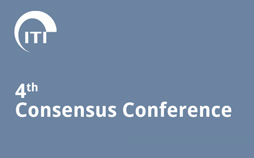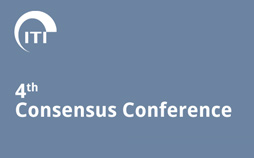
Bone Augmentation Procedures in Extended Alveolar Ridge Defects
Definition of Terms
The following definitions were adopted from the Glossary of Oral and Maxillofacial Implants(1):
- Onlay graft: A graft used in block form and fixed upon the cortical surface of the recipient bed with a screw. The origin may be an autograft, allograft, alloplast, or xenograft.
- Maxillary sinus floor elevation: An augmentation procedure for the placement of implants in the posterior maxilla where pnuematization of the maxillary sinus and/or vertical loss of alveolar bone has occurred.
- Split-ridge technique: An augmentation procedure to increase the width of a narrow residual ridge by surgically splitting it or expanding it with a series of osteotomes of increasing diameter.
- Distraction osteogenesis: A surgical process for reconstruction of skeletal deformities that involves gradual controlled displacement of surgically created fractures to simultaneously expand soft tissue and bone volume.
References:(1) Laney WR (ed). Glossary of Oral and Maxillofacial Implants. Berlin: Quintessence, 2007.
Consensus Statements
General Statements
Several surgical procedures are available and effective for the augmentation of deficient edentulous ridges, allowing implants to be placed. However, most of the studies are retrospective in nature, with small sample sizes and short follow-up periods. Therefore, direct comparisons between studies should not be made and definitive conclusions cannot be drawn.
Onlay Bone Grafting of Severely Resorbed Edentulous Ridges
- Autogenous onlay bone grafting procedures are effective and predictable for the correction of severely resorbed edentulous ridges to allow implant placement.
- Uneventful healing/consolidation of grafts taken from intra- and/or extraoral donor sites occurs in the majority of cases.
- Acceptable survival rates of implants placed in maxillae and mandibles reconstructed with autogenous onlay bone grafts are reported.
- The survival rates are slightly lower than those of implants placed in native bone.
Maxillary Sinus Floor Elevation Using the Lateral Approach
- Maxillary sinus floor elevation procedures are predictable for augmentation of bone in the posterior maxilla.
- A variety of grafting materials can be safely and predictably used, alone or in combination. These materials include autografts, allografts, xenografts, and alloplastic materials. The use of autografts does not influence survival rates of rough-surfaced implants but may reduce healing times.
- The quantity and quality of bone in the residual maxilla influence survival rates of implants independently from the type of grafting procedure.
- Survival rates of rough-surfaced implants placed in augmented maxillary sinuses are similar to those of implants inserted in native bone.
Split-Ridge/Ridge-Expansion Techniques with Simultaneous Implant Placement
- Split-ridge and expansion techniques are effective for the correction of moderately resorbed edentulous ridges in selected cases.
- Survival rates of implants placed at sites augmented using split-ridge/ridgeexpansion techniques are similar to those of implants inserted in native bone.
Split-Ridge Technique with Interpositional Bone Grafts
- There is a lack of evidence concerning the split-ridge technique with interpositional bone graft and delayed implant placement.
Vertical Distraction Osteogenesis
- Alveolar distraction osteogenesis can be used to augment vertically deficient alveolar ridges in selected cases.
- Alveolar distraction osteogenesis has a high rate of complications, which include change of the distracting vector, incomplete distraction, fracture of the distracting device, and partial relapse of the initial bone gain.
- Survival rates of implants placed at sites augmented using distraction osteogenesis are similar to those of implants inserted in native bone.
Le Fort I Osteotomy with Interpositional Autogenous Bone Grafts
- Le Fort I osteotomy with interpositional autogenous bone grafting can be used successfully to treat extreme atrophy of the maxilla associated with severe intermaxillary discrepancy.
- This procedure is technically demanding and is associated with considerable postoperative morbidity.
- Survival rates of implants placed after Le Fort I osteotomy with interpositional autogenous bone graft are lower than those reported for implants placed in native bone.
Clinical Recommendations
Bone augmentation procedures should always follow a prosthetically driven plan to allow ideal three-dimensional implant positioning. The concept of “prosthetically driven bone augmentation” should be taken into consideration whenever possible.
Autogenous Onlay Bone Grafting of Severely Resorbed Edentulous Ridges
- Onlay bone grafting is a technique-sensitive procedure and is recommended only for well-trained clinicians.
- Both intraoral donor sites (including the mental symphysis, the mandibular body and ramus, and the maxillary tuberosity) and extraoral donor sites (including the iliac crest and the calvarium) can be used for collecting autogenous bone.
- The choice between intraoral and extraoral sites is mainly related to the quantity of bone necessary to reconstruct the deficient alveolar ridge. Preference should be given to donor sites where the cortical component is more prevalent, in order to reduce the risk of early or late resorption of the graft.
- Bone harvesting from the mental symphysis is associated with relevant morbidity, and the quantity of available bone is frequently limited. Neural damage to the incisal nerve occurs frequently. Therefore, the mental symphysis should not be the first choice for harvesting.
- Bone harvesting from the maxillary tuberosity is followed by low morbidity but is not well documented. The quality and quantity of available bone is often poor. Indications are limited to reconstruction of small defects.
- Bone harvesting from the mandibular ramus offers good quality and quantity of available bone, due to the possibility of harvesting from both sides.
- Bone harvesting from the iliac crest offers high quantities of bone. However, the cancellous bone component is dominant and may lead to a higher risk of unpredictable bone resorption. When bone is harvested from the anterior iliac crest there may be associated gait disturbances.
- Bone harvesting from the calvarium offers greater quantities of highly corticalized bone and is associated with low morbidity.
- Accurate modeling and stabilization of the graft with screws, and tension-free primary closure of the overlying flaps, are fundamental for the success of the procedure.Overcorrection of the defect is recommended to compensate for the potential risk of bone resorption. Coverage of the bone grafts with a low-resorption–rate xenograft/alloplastic material, with or without a membrane, may be indicated to reduce bone resorption.
- The economic and biologic costs of bone transplantation must be carefully weighed. In selected clinical situations short and/or reduced-diameter implants may be considered instead.
- The severely atrophic edentulous maxilla frequently needs onlay bone grafts due to poor quality of the residual bone and the presence of pneumatized cavities, including the maxillary sinus and the nose.
- Both implant placement in conjunction with bone grafting and delayed implant placement have been proposed. Delayed implant placement is recommended.
Split-Ridge/Ridge-Expansion Techniques:
- Split-ridge/ridge-expansion techniques are indicated in selected situations where atrophy of the edentulous ridge has developed horizontally and cancellous bone is present between the oral and facial cortical plates, and adequate residual height exists.
- Excessive facial inclination of the alveolar ridge may contraindicate this procedure, as it may worsen the initial situation from a prosthetic point of view.
- The presence of undercuts may increase the risk of bone fracture.
- This technique is mainly indicated in the maxilla. Ridge expansion in the mandible is frequently difficult due to the rigidity of the bone.
Vertical Distraction Osteogenesis:
- Vertical distraction osteogenesis is a techniquesensitive procedure and is recommended only for well-trained clinicians.
- Indications of this technique should be limited to vertically deficient ridges with adequate residual width.As the segment to be distracted has to be at least 3 mm in height, severely deficient mandibles are not good candidates due to the risk of neural damage and/or mandibular fracture.
- The presence of maxillary sinus and/or nasal cavities may be contraindications.
- The rigidity of the palatal mucosa may negatively influence the distraction vector.
Le Fort I Osteotomy with Interpositional Autogenous Bone Grafts:
- Le Fort I osteotomy with interpositional autogenous bone grafts is indicated in cases of extremely severe resorption, and where there is an unfavorable horizontal and vertical intermaxillary relationship.
- This procedure is technique-sensitive and is recommended only for well-trained clinicians.
Sinus Floor Elevation Using the Lateral Approach:
- In sites with limited initial bone height not allowing insertion of the desired implant length, sinus floor elevation via the lateral approach can be used to increase the bone height.
- As atrophy of the maxilla occurs three-dimensionally, the edentulous posterior maxilla should not only be evaluated in terms of initial bone height below the maxillary sinus but also in relation to any vertical and horizontal ridge deficiencies. If relevant vertical/horizontal intermaxillary discrepancy is present, an onlay bone augmentation may be considered to create both sufficient bone volume and proper intermaxillary relationships, to optimize implant placement and related prosthetic restoration.
- Data related to the initial clinical situation should be reported, and defects classified according to well-defined criteria.
- If the initial bone height allows primary implant stability, simultaneous implant placement (onestaged) can be recommended. In situations where primary stability cannot be achieved, the elevation of the sinus floor should be performed in a separate surgical procedure followed by delayed implant insertion (two-staged).
- Rough-surfaced implants should be utilized. Coverage of the access window with a membrane may be considered.
Sinus Floor Elevation Using the Transalveolar Approach:
- Sinus floor elevation using the transalveolar approach can be recommended in sites with sufficient alveolar crest width, initial bone height of 5 mm or more, and relatively flat sinus floor anatomy.
- The main disadvantage of this technique is possible perforation of the sinus membrane, which is difficult to manage. Therefore, the transalveolar technique should only be performed by clinicians with experience in performing sinus floor elevation via the lateral approach.
- A prerequisite for using this technique is that primary implant stability is achieved.
Downloads and References
Related items
Share this page
Download the QR code with a link to this page and use it in your presentations or share it on social media.
Download QR code
